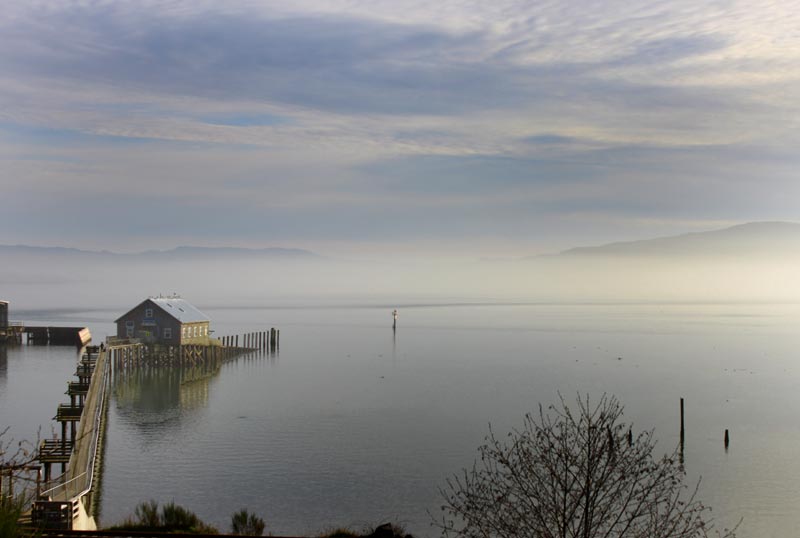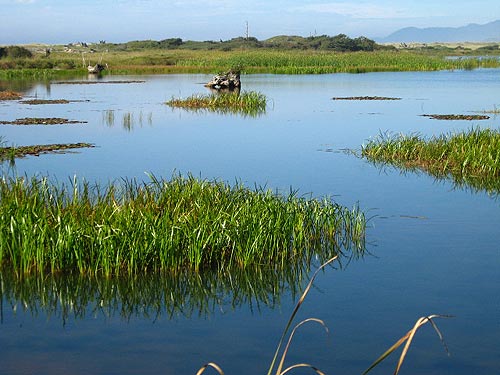Seeing Mysterious Work in N. Oregon Coast Waters? It's Biologists in Tillamook Bay
Published 05/19/22 at 3:15 AM PST
By Oregon Coast Beach Connection staff
Includes exclusive listings; some specials in winter
In Cannon Beach:
Includes rentals not listed anywhere else
In Manzanita, Wheeler, Rockaway Beach:
Some specials for winter
In Pacific City, Oceanside:
Some specials for winter
In Lincoln City:
Some specials for winter
In Depoe Bay, Gleneden Beach:
Some specials for winter
In Newport:
Look for some specials
In Waldport
Some specials for winter
In Yachats, Florence
Some specials for winter
Southern Oregon Coast Hotels / Lodgings
Reedsport to Brookings, places to stay; winter deals
(Tillamook, Oregon) – Soon you will start to see a group of people in one north Oregon coast bay wading in the water, hanging around in boats, and carefully going over the sand flats. Tilllamook Bay will be the subject of some mysterious activity. (Photo ODFW: researchers using megacoring pumps)
You can put away your tinfoil hat. It's only science at work, as researchers from Oregon Department of Fish and Wildlife (ODFW) will be conducting surveys on bay clams and those that live in the estuaries. Biologists will be toiling here through October. It all creates something useful for average clammer.
This group of biologists are from ODFW's SEACOR (Shellfish and Estuarine Assessment of Coastal Oregon) program. The organization does periodic surveys of bay clam populations on all of the Oregon coast's major bays, and this year the focus is on Tillamook Bay.
Surveys like this are conducted to look into the various recreational species of clams (butter, cockle, gaper, and littleneck clams), researching locations, numbers and their preferred habitats. Other types of shellfish are examined in the surveys as well, including juvenile Dungeness crabs and purple varnish clams.

Photo Oregon Coast Beach Connection
The data is then used to create detailed maps of where clamming is the most productive, a highly useful tool for recreational clammers on the Oregon coast. These maps inform the public on abundance of the recreationally-targeted species as well, so clammers can maximize efficiency on the tide flats.
Surveys also document changes to species and their habitats, adding to a growing database of information on the health of Oregon’s bay clams and estuaries.
Residents and visitors will see the SEACOR biologists particularly busy at low tides. ODFW said they will be following GPS coordinates to specific spots on the tide flats, and they will be laying out quadrats, recording information on the habitats of each species and identifying the presence of gaper or butter clams by their siphon shows on the tide flat surface. Biologists will also rake the mud or sand down to about six inches looking for cockle or littleneck clams.
A few sites will require surveying in greater detail by hand digging or using “megacoring” equipment – which pumps out sediment and simultaneously collects clams that are deeper down. SEACOR biologists megacore sites in shallow areas of the bay and work with contracted divers to conduct megacoring surveys in the subtidal zone.
Bay clammers can get detailed maps for Alsea, Coos, Netarts, Siletz, Tillamook and Yaquina bays on myodfw.com or check the SEACOR page for more information on the project.
ODFW also uses SEACOR survey information to manage the commercial bay clam fisheries in Tillamook Bay. The Tillamook Bay Clam Advisory Committee is currently working with ODFW to develop recommendations for management of the recreational and commercial bay clam fisheries.
Hotels in Tillamook Bay - Where to eat - Tillamook Maps and Virtual Tours
Cannon Beach Lodging
Nehalem Bay Lodgings
Manzanita Hotels, Lodging
Three Capes Lodging
Pacific City Hotels, Lodging
Lincoln City Lodging
Depoe Bay Lodging
Newport Lodging
Waldport Lodging
Yachats Lodging
Oregon Coast Vacation Rentals
Oregon Coast Lodging Specials

Photo ODFW: crews taking sand samples

More About Oregon Coast hotels, lodging.....
More About Oregon Coast Restaurants, Dining.....
LATEST Related Oregon Coast Articles
Bringing the Lincoln City events back to their roots
Final Third of Oregon Coast Given Okay to Start Commercial Crabbing
Majority of the coast began crabbing last week. Marine sciences
Newport Gets Rescue Copter Back After Lawsuit, Still Fighting ICE Dentention ...
The move would have left the closest helicopter rescue 100 miles away. Safety
What's Up (and Not Up) for King Tides on Oregon / Washington Coast This Week
No large wave events but some flooding, caution needed still
Holiday Rager on South Oregon Coast All About Mountain Biking
Wild Coast Trails Holiday Ride Saturday, November 22 in Agness near Gold Beach. South coast events
Waves 17 to 26 Ft Along Oregon Coast: Surf Advisories, Sneaker Waves
A good show from Washington southward but some deadly possibilities. Weather
Dramatic Oregon Coast Police Chase Includes Flaming Wheel Through Lincoln Cit...
Chase began in Newport and ended in Lincoln City, over 70 mph. History, true crime
Geminid Meteor Showers, Comet Atlas 31 This Week Above Oregon, Washington
Geminids peak Dec 12, 13; comet closest to Earth Dec 19. Astronomy, weather
Back to Oregon Coast
Contact Advertise on Oregon Coast Beach Connection
All Content, unless otherwise attributed, copyright Oregon Coast Beach Connection. Unauthorized use or publication is not permitted





















































